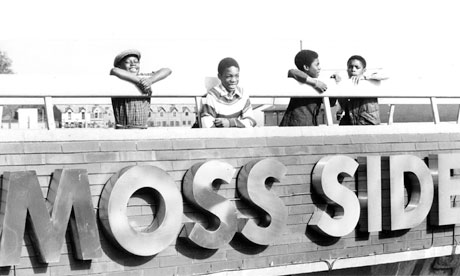Defining a City – Concluding My Manchester Visit
 L.S. Lowry’s depiction of Piccadilly Gardens
L.S. Lowry’s depiction of Piccadilly Gardens
For many Brits living in the mid-20th century, the above image defined the city of Manchester. “Everybody thought we walked around with little dogs,” my landlady Kate told me, mocking the impression of Manchester that still stays with many citizens of the UK. In a time before the internet, though, paintings such as that of L.S. Lowry’s might have been the only way some people experienced the town at all. Plain, hunched over “matchstick men” walked from shopping centers or rust-colored factories that billowed with smoke. Ailing children stood with pained expressions, some on crutches or suffering from amputations. Lowry did not idealize; he painted an unadorned industrial life. And yes, there were plenty of dogs.
And, at that time, it was a good representation of life in Manchester. It’s a city that came to be known for its cotton industry during the mid-19th century, and while this brought growth and progress to the city, it also brought conditions of illness and a lack of sanitation described by one historian as “Hell upon Earth.” Mark Twain once said that he would like to live in Manchester, if only because the transition from life in the city to death itself would be an easy one.
This was, of course, over a century ago. The Lonely Planet guide describes Manchester as “a modern metropolis that has embraced 21st-century style and technology like no other in England.” In a lot of ways, it is–my visit was marked by trips to museums, concert venues, and plenty of restaurants, all attracting young college students studying in the city. While one man on a BBC message board claimed Manchester was little more than “unemployment, deprivation, poor health, and rain,” another man quickly fired back that Manchester stands among Europe’s greatest cities.
Well, I was there for a little more than four weeks. So which is it?
Actually, I have to wonder if it’s the sort of question we should ask at all.
If Lowry had painted Manchester during the 90s, he may have painted a scene like this. During this time, the area was referred to as “Gunchester.” Talking to a neighbor I learned that only a few years ago a man sat on our street wearing a bulletproof vest, hoping to slash tires and steal stereos. This story was followed up by the legend of a particular gang member who tried on a vest at a local gun shop, only to shoot the store owners when they asked for a deposit.
All of this took place very close to an area of Manchester known as Moss Side. I walked through the neighborhood countless times during my stay in Manchester. It was an area of brick homes, ivy climbing its surfaces to cover fading graffiti. Children played near the Moss Side community center as locals escaped the rain under the roofs of bus stops. There were many storefronts in the area that sold fruits or other groceries, but it was mainly a residential area–it was a place where people lived and raised families.
After I heard about the area’s history, though, I became nervous during my routine walk. People I had before ignored began to look dangerous; I could feel my heart beating as I made a trip to ASDA around 11 pm at night.
Later, I told my adviser about the area. “Moss Side is nothing, it is fine”, she told me. And it seems to be; when Manchester was, in 2009, described as imitating The Wire, the remarks were met with dismissal. Police reports showed that gun crime had fallen by over 80% in the previous year. Such a comparison to the gang-related crime and violence of the HBO TV series was called “sensationalistic.” Hearing about this, I felt ashamed to have let legends of the area’s crime prevent me from enjoying my nightly walks.
That’s why I hesitate to describe Manchester in a few sentences when people ask me what the city is like. It’s a vibrant yet humble working class city that is hailed as the rising star of English towns and demonized as a crime-ridden slum. People are polarized when it comes to Manchester, it seems, and the opinion you get of the city will depend heavily on the background and experience of the person you ask.
After all, would you visit Flint if this bumper sticker was all you knew about our city? Most of us are rightfully upset by this sort of representation. At the same time, though, can you really understand Flint if you are unaware of the depiction it faces? It’s for this reason that I wouldn’t want to tell somebody Manchester was “a modern metropolis”–what does this really say? Not much. The same could be said of countless cities, all with entirely different characters. Something is lost with such a sanitized, focus-group approved description. What you’re getting is just one piece of the puzzle.
Puzzle pieces found near Stamford St, Manchester
Another piece of that puzzle would depict troubles with gang-related crime. Several others would illustrate inventions and discoveries such as the Manchester Mark I or graphene. Countless more would tell the stories of those I met during my stay: artists, music journalists, scientists, professors, all willing to offer hospitality and a new perspective on the UK and life itself. A few more of those pieces would probably also show Manchester exactly as Lowry saw it, matchstick men and all. The truth is, though, that having been there only five weeks, I don’t know if I can put the puzzle together.
When I think about my experiences, though–bus rides past the Church of Saint Mary, a walk through the intricate Whitworth Hall past the old office of Alan Turing, or even the sweater-wearing ram at the University of Manchester Museum–the pieces start to fit together a little bit better.






